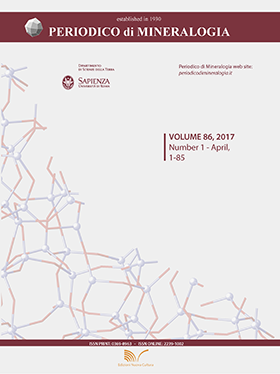Late-magmatic neptunite in composite peralkaline granite-syenite nodules within a Pleistocene basalt (Bulhary, Slovakia)
DOI:
https://doi.org/10.2451/2016PM651Keywords:
neptunite, leakeite, hollow sanidine, peralkaline granite, alkali basalt, xenolith, Pannonian Basin, Western CarpathiansAbstract
Neptunite – KNa2Li(Fe,Mn,Mg)2Ti2Si8O24 – was identified in peralkaline, apatite-rich, silica-oversaturated, sodium metasilicate-normative granite entrained as composite granite-syenite xenoliths in Pleistocene alkali basalts of the Carpathian back-arc basin (the Pannonian Basin). The investigated xenoliths are specific by skeletally grown potassium feldspars associated with quartz, pyroxene, amphibole and fluorapatite. Neptunite associated with quartz, amphibole, Na-Nb-REE-rich titanite and an unknown phosphate crystallize within hollows in Fe-rich potassium feldspars. Interstitial amphiboles correspond to katophorite, richterite, and rare arfvedsonite. Amphiboles from feldspar hollows exhibit low analytical totals, high alkalis (up to 11 wt. % Na2O+K2O), deficient C-site and excessive A-site cations. The analytical bias can be eliminated by the addition of 0.96-1.04 apfu Li (1.66-1.81 wt. % Li2O) to get the amphibole stoichiometry similar to that of leakeite, albeit with high Fe3+ and Mn3+ contents. The fluorapatite shows the 5Ca2+ = 3Sr2+ + Na+ + LREE3+ substitution diagnostic of peralkaline rocks. Pyroxene compositions are aligned parallelly with the diopside-aegirine join, thus reflecting gradually increasing oxygen fugacity during the magmatic differentiation. The strongly oxidizing conditions are further projected in up to 22 mol. % KFe3+Si3O8 component in the potassium feldspar, enrichment in high-valence C-site cations (Fe3+,Mn3+, Nb, Zr) in amphiboles, high proportion of a hypothetical ferri-neptunite component ÿ(M+)2Li(Mn,Fe3+)3TiSi8O24, and the presence of accessory hematite. Neptunite-bearing, oxidized peralkaline granites are another member of the suite of Pliocene intra-plate A-type granitoids occurring in northern promontories of the Pannonian Basin. The strongly Al-depleted granite resembles lamproite-derived residual melts formed by the fractional crystallization of diopside.
Downloads
Published
Issue
Section
License
Copyright (c) 2017 PERIODICO di MINERALOGIA

This work is licensed under a Creative Commons Attribution 4.0 International License.


